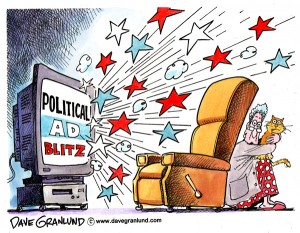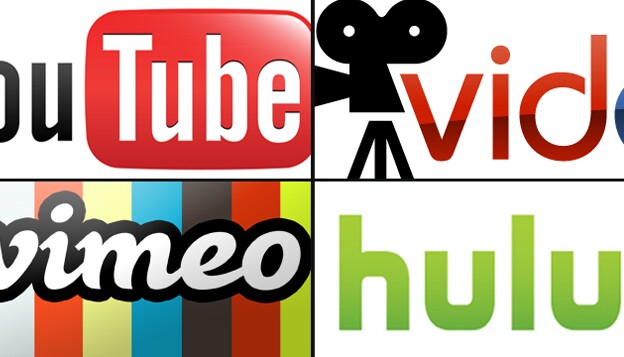Rolf Gutknecht is vice president, director of account services for LA ads. To discuss your thoughts with Rolf on this blog or any marketing matters, email via this link, or visit www.LAadsMarketing.com. You can also connect with Rolf on LinkedIn.
 I’m so glad it’s over. Probably like you, my home phone was being called at an increasing rate the closer that we got to Election Day. Candidates’ faces and names were everywhere and on everything from direct mail to lawn signs and outdoor boards to TV and radio commercials. As annoying as it was, there were a number of messaging strategies and tactics that caught my attention because they were executed exceedingly well, which, as marketers, we should consider adding to our communication toolkits for use tomorrow, next week or next month. For as we all know, your customer and prospects are still being bombarded with marketing messages each and every day by both you and your competitors.
I’m so glad it’s over. Probably like you, my home phone was being called at an increasing rate the closer that we got to Election Day. Candidates’ faces and names were everywhere and on everything from direct mail to lawn signs and outdoor boards to TV and radio commercials. As annoying as it was, there were a number of messaging strategies and tactics that caught my attention because they were executed exceedingly well, which, as marketers, we should consider adding to our communication toolkits for use tomorrow, next week or next month. For as we all know, your customer and prospects are still being bombarded with marketing messages each and every day by both you and your competitors.
So let me share with you some strategies and tactics used by politicians leading up to November 8th that are worth remembering today.
1) Understand the takeaway
Truth is, these folks do have some things to teach us marketers, particularly regarding messaging. They see the world a bit differently than we do, and use techniques most people didn’t learn in school or on the job, such as: It’s Not What You Say, It’s What People Hear. You can have the best message in the world, but the person on the receiving end will always understand it through the prism of his or her own emotions, preconceptions, prejudices, and existing beliefs. We focus too much of our energy on finding the best way to sell our message, and too little on understanding the filters consumers have as we deliver it. Political marketers care more about takeaways than inputs.
2) Make it look good
Did you see the biographic videos produced by the two Presidential candidates? They were extraordinarily well done. A number of other political ads were also well done from a storytelling and video perspective. They stayed on message concentrating on the one critical point (not 4 or 5 points) that they wanted to make sure was communicated. The videos were shot and narrated well. They didn’t hire amateurs to do their work but had expert writers and producers creating the content. Like with your business, there’s too much at stake to do cheap stuff because everyone knows what cheap means. People interpret what your company or brand stands for based on the quality of creative and the media channel it’s presented on. Don’t go out until you look good.
3) Be the genuine article
Business marketing sometimes seems to stretch the truth a bit too much. When marketing messages are sufficiently visible and sufficiently wrong, the press will get wind and call you on the truth of your marketing. Transparency of your brand could never be more important. It is less about giving the appearance of perfection and more about being genuine and human as we build relationships. While it’s critically important to craft your story and advocate for the benefits of your product or service, it’s not fine to lie about them. My mom use to tell me “Lies have short legs,” meaning you can’t outrun the truth …so don’t stretch.
4) You are who you say you are
In the world of politics, I would argue that there’s nothing as important as branding and having people recognize what the brand stands for. Brand consistency is always maintained. Unlike politicians, too many companies struggle with this, swinging wildly from one branding concept to another. In political ads, everything from the taglines to the logos to the visuals has been choreographed beautifully. Get your branding figured out right now. Here are a few questions to ask yourself to determine if your branding is clear:
5) Be social…not antisocial
Politicians don’t just post stuff to their respective Twitter or Facebook accounts and hope people will read it. Rather, they actually engage with their social media audience. They post images and video. They have their immediate families and supporters use social media regularly. How is your company using social media to spread the good word about your company? I’ll be the first to say that spending a lot of time, money and resources on social media is not right for every company, maybe not even yours, but without some presence, you’re letting the competition become more visible and be seen as a legitimate business partner at your expense.
6) Tell the story again and again
Why are most political ads annoying? Some of it is the content, but I think most of the annoyance is the sheer quantity of political advertising as elections draw near. But politicians know one thing: without a communications budget that allows you to be out in the market in a way that shows you’re a player, you won’t get the job done. Far too many companies who do “invisible marketing” base their companies short and long term success on thinking that customers will pick them over a brand that’s actively marketing and better known. The takeaway is that repetition is key …but too much repetition annoys.
As I said earlier, I’m glad the madness of the political advertising season is over. But I’m grateful to have observed it from a marketer’s perspective, because it’s a reminder that each and every day customers and prospects are voting who they want to do business with. Let the winner be you.
# # # #
Rolf Gutknecht is vice president, director of account services for LA ads. To discuss your thoughts with Rolf on this blog or any marketing matters, email via this link, or visit www.LAadsMarketing.com. You can also connect with Rolf on LinkedIn.
 As a partner in a thriving marketing firm that targets companies with $20-$100 million in annual sales, one of my responsibilities is that of business development. While I learn something in each conversation with people in marketing leadership positions, many times after I hang up the phone, I say to myself, “there’s another one who’s losing sales to their competitors!” Mainly that’s because these folks have adopted some misconception about marketing as the “truth” that they can’t and won’t let go of no matter what. So while they say they’d like their sales to be stronger, their year-over-year sales won’t change much or, in some cases, will decrease from one year to the next.
As a partner in a thriving marketing firm that targets companies with $20-$100 million in annual sales, one of my responsibilities is that of business development. While I learn something in each conversation with people in marketing leadership positions, many times after I hang up the phone, I say to myself, “there’s another one who’s losing sales to their competitors!” Mainly that’s because these folks have adopted some misconception about marketing as the “truth” that they can’t and won’t let go of no matter what. So while they say they’d like their sales to be stronger, their year-over-year sales won’t change much or, in some cases, will decrease from one year to the next.
So, let’s do a quick run-through of 5 most common fallacies that I hear. Hopefully none of these sound as familiar to you as they do to me.
I can grow my sales and “share of pie” with a smaller budget than my competitors
When I hear this, it generally implies two things to me: 1) Either your competitors are wasting a big portion of their marketing budget on initiatives or messaging that doesn’t connect with the customers or, 2) your marketing partners are fantastic because they’re willing to work for less than the average market price in order to do the wonderful work they do…which I have a hard time believing is the case. Oh, and then let’s not forget about the inability of these companies to track how much money the competitor is actually (over) spending on marketing.
The reality is this: if your company is spending a good deal less than the competition, you’re probably not making any significant gains in market share. Yes, there might be a competitor that’s overspending, but my experience working with companies from the Fortune 100 to small mom-and-pops is that you don’t pose a serious competitive threat unless your marketing budget is in the same ballpark with your competition….it’s just one of those “marketing truths.”
Marketing’s role is to generate new business
You’ll get no argument from me that one of the jobs of marketing is to generate new business, directly or indirectly. But just as important, marketing’s role is to make existing customers come back for more, that is making customers loyal to the brand. Many businesses are so focused on attracting new customers that they tend to ignore – or even walk away from – the existing ones. Yes, new customers are constantly needed, but truly successful companies prosper on their ability to retain the customers they’ve already acquired. The reason is simple: finding new customers is expensive and time-consuming. Let the following research statistics wash over you….
New business is always good but don’t forget who’s paying the bills.
We’re looking to be more visible with our customers because it leads to better engagement
Reaching the right balance between quality and frequency of the message requires careful consideration. There is a common belief among some that the more we communicate with our customers, the more “engaged” they will become. In fact, not knowing when to “zip it” is a classic marketing mistake that too many marketing people make. If marketing is about building relationships with customers, over-marketing is the best way to kill the relationship and send the customer or prospect heading for the door. A social engagement study entitled “The Social Breakup” prepared by ExactTarget, provides clear evidence of what happens to customer relationships when the marketer comes on too strong:
Guess the biggest reason people break up with companies? (Drum roll)…Too much marketing. The study showed that:
In short, increasing the frequency of communication shouldn’t be your marketing goal. Constantly improving content quality should be.
We don’t need a marketing firm because we can do it in-house for less
It’s the #1 thing I hear the most. A survey conducted by American Express Canada shows that “84% of small business owners say branding is important to overall business success, but only 14% hire third-party experts to help with branding.” I am not surprised by the results, and I can only guess the reasons: agency expense, the desire to have full control over the creative process, poor prior experience with an agency, or possibly the ability to make changes faster on one’s own. So, instead of looking for an outside marketing partner, many companies decide to hire a “marketing person” who wears many hats: graphic designer, social media specialist, copywriter, etc. Let’s be honest, no marketer can be a specialist in everything, unless the company is willing to cut corners on how it presents itself to the world.
Now please understand, I’m not trying to bash the in-house marketing department as there are a lot of smart and talented people out there working for companies. Rather, my point is this: the right outside marketing partner will bring a focus to the marketing initiatives or project, resulting in faster execution time; will come in with an original point of view – more in line with how your customer will interpret the messaging; develop much fresher creative (no “vanilla” wallpaper stuff that gets passed over, and; deliver a much higher level of production quality. Try this on for size: open up 5 trade or consumer magazines and tag or cutout 10 ads that stop you in your tracks… ones that convey a strong value proposition, ones that you wish your firm had done! My completely biased but nevertheless absolutely accurate guess is that all 90% of those ads you clipped out were created by a marketing or advertising agency.
We’re looking for something beyond traditional marketing because that kind of advertising is dead
The internet is chock full of advice on how your company should abandon traditional “old school” communication methods and make the switch to online. It would seem like TV, print ads, billboards, and radio are dying and not worth considering in the overall communication strategy. Yet, research (and lots of it) say this is an incorrect assumption. I think we can agree that the best marketing communication strategy uses a mix of offline and online tactics to reach the target audience. (Do yourself a favor and visit www.marketingcharts.com and subscribe –it’s free. Here you’ll get daily research updates on a wide range of topics including how traditional channels are preferred over digital depending on the audience.)
While it’s true that more money is shifting towards digital, the traditional marketing channels are still heavily required in many business environments. In fact, when Google started getting serious competition, they started running…wait for it…TV ads! When Dollar Shave Club saw that their growth was limited by only online marketing, they started using those old, traditional channels that have in turn made them a rising star company. When there’s a product launch, a sale or just about any other occasion where you need to reach a mass audience quickly and effectively, there’s still no substitute for paid media…and even the dot-coms know it. Think about this, in 2014, the average cost of a 30-second Super Bowl ad was more than $4 million. No CEO or Marketing Director would ever approve such a budget without taking ROI into account, right?
So as I noted earlier, hopefully none of these sound familiar to you. But if on the other hand you’ve heard or said one of these things in the past, know that a lot of confusion, frustration and unrealistic expectations can be eliminated by seeing the world through a different set of lenses.
####
Rolf Gutknecht is vice president, director of account services for LA ads. To discuss your thoughts with Rolf on this blog or any marketing matters, email via this link, or visit www.LAadsMarketing.com. You can also connect with Rolf on LinkedIn.
As we all know, Pinterest and Instagram have become staples on the social media scene. The right visuals (from photos to quotes to inspirational messages) have great appeal and serve as motivation for many. With that in mind, here are some interesting visuals coupled with some content concerning marketing issues that face marketing teams almost daily as they work towards creating the change in the way people use and interact with their company’s products or services. Short, sweet and fun. Click away! 
The average attention span today is roughly 9 seconds…like that of a goldfish. Nine seconds to communicate a message, earn a little bit of loyalty, build a little bit of trust so you can continue the conversation before your customer starts getting distracted! So what could you possibly say in that time or less to get someone’s attention? It starts with presenting your message in clever and unexpected ways. It grabs people’s attention and has them focusing on the message and not thinking about the other stuff that could come into their mind. They’re engaged and captivated. In doing so, it allows you to persuade them, get them to trust you, get them to believe you, get them to want to connect with you. A shift in perspective from speaking about yourself to speaking from the audience’s point of view can be remarkably effective. Witness a beautiful commercial for a British online content company featuring a blind man whose original cardboard sign talks about himself, “I’m blind. Please help.” But when a caring passer-by changes the words to be more audience-focused, something powerful happens. The symbolism is powerful. To read more, click here.
Social media as a pathway to sales is almost certainly not going to work to the degree you want. There…I said it. While social media can be a valuable marketing tool, it’s not magic and it cannot and won’t replace everything that came before it. There’s no quick success and very few programs break through. Coca-Cola says it can find no correlation between “buzz” on Twitter and actual unit sales. Nissan admits it has no idea if social media helps it shift cars. MasterCard can’t tie its social investment to revenues. Don’t take my word for this. Go online and do your own research and see for yourself. In fact, there remains little evidence social media does anything to boost brands’ bottom lines. So then why use social media at all? The reason is that it is an impactful vehicle for empowering advocacy and we know that’s extremely important for brand health and profitability. Social media, if done right, can capitalize on what brand equity your company has already built up. To read more, click here.
 When was the last time you/your marketing team asked the question “I wonder what would happen if we ________.”Crazy ideas have changed the way we go about living our lives. Knowing this, why is it that many marketers still don’t trust the crazy idea when it shows up unexpectedly especially, since crazy ideas, not safe ideas, are the game changers that propel companies forward? In today’s competitive, me-too world, if your product isn’t a legitimate leader in a category, it’s certainly a far better choice to come up with a new value story around your own product or service rather than trying to compete price-wise on the value that was generated by a competitor. You might want to be thinking about a crazy idea that will create a new meaning around your brand. Embrace that mindset so much so that the next time an idea is presented by your marketing department and someone outside of that department says “That’s a crazy idea,” you’ll say, “Thanks, we love it as well!” To read more, click here.
When was the last time you/your marketing team asked the question “I wonder what would happen if we ________.”Crazy ideas have changed the way we go about living our lives. Knowing this, why is it that many marketers still don’t trust the crazy idea when it shows up unexpectedly especially, since crazy ideas, not safe ideas, are the game changers that propel companies forward? In today’s competitive, me-too world, if your product isn’t a legitimate leader in a category, it’s certainly a far better choice to come up with a new value story around your own product or service rather than trying to compete price-wise on the value that was generated by a competitor. You might want to be thinking about a crazy idea that will create a new meaning around your brand. Embrace that mindset so much so that the next time an idea is presented by your marketing department and someone outside of that department says “That’s a crazy idea,” you’ll say, “Thanks, we love it as well!” To read more, click here.
If you want to have passionate customers and dedicated partners, you must first inspire strong responses. But as you attract fans, you’re also bound to get the critics or “Haters.” It’s OK to have some folks (not too many, though) who will not like your brand. The undeniable reality is that if you’re not eliciting a negative response from someone somewhere, then you’re probably not that fascinating to anyone. Think about it, even Apple has Haters as does Starbucks and it hasn’t hurt them. Alternatively, you have the advocates, evangelists, loyalist…the Lovers. They don’t just buy your product or service, they also accept price increases and forgive occasional “issues.” They’re loyal and not just buying your products for price or utility. In the middle are the Lukewarmers. They have a really bad habit of not caring. They won’t buy your product unless it’s the cheapest or most convenient option which means they’re only buying you until a cheaper or more convenient alternative comes around. In today’s marketplace, this middle ground is death!! Not caring is not buying. Not caring is inaction. The world is not changed by people who sort of care or don’t care at all. Stop focusing on the Lukewarmer. Start by having your marketing and advertising be imaginative, original and fresh. To read more, click here.
Having dealt with all sorts of companies and people, I believe the Number One reason for boring “vanilla” marketing messages is the result of trying to please all the people all the time. Fighting the desire to be all things to all people lets you: 1. Stand out from the herd; 2) Attract the like-minded; and 3) Create stronger connections. Vanilla brands might not have enemies, but they also don’t have passionate advocates whose enthusiasm spreads. In order to win the race, you can’t stand still. Vanilla marketing is standing still. To stand out, to be different, to be memorable, takes boldness. It takes being “a real Marketer”. So, however you go about it, stop defaulting to dishing out plain vanilla marketing and start scooping out interesting flavors (think “Cherry Garcia”; “Chubby Hubby”; or “Chunky Monkey”, etc.) that stand out and are uniquely your own. To read more, click here.
So there you have it. 5 visuals that speak to different marketing challenges and opportunities. Maybe these visuals will stick with you for awhile and even change the way that certain projects, campaigns and programs are developed and executed. Seeing is believing.
####
Rolf Gutknecht is vice president, director of account services for LA ads. To discuss your thoughts with Rolf on this blog or any marketing matters, email via this link, or visit www.LAadsMarketing.com. You can also connect with Rolf on LinkedIn.
 A few weeks ago, I was faced with needing to find a new dentist. So, the search began and the more I looked around, the more it showed just how many touchpoints came into play prior to – and after – a selection being made.
A few weeks ago, I was faced with needing to find a new dentist. So, the search began and the more I looked around, the more it showed just how many touchpoints came into play prior to – and after – a selection being made.
As we know, customers experience your brand in numerous ways and each of these touchpoints molds the customer’s impression of your company’s brand. If the brand is a promise you make, then the customer experience is the fulfillment of that promise. The customer experience can’t be left to chance. It has to consistently reinforce the brand promise across every customer touchpoint or the value of the brand itself is at risk.
So, after thinking about what your brand stands for and what sets it apart, it’s time to look outward. After all, if a brand is built and nobody hears it, does it make a sound? In not-so-distant marketing past, reaching consumers meant connecting through just a few channels: a catalog, a radio spot, a store visit, a customer service line, a salesperson…You get the idea. However, the number of channels for reaching customers has exploded in recent years. Think about it: when was the last time you made a major (or even not-so-major) purchase decision, personal or for business, whether a product or service, through a single channel? In fact, it’s more likely that your purchasing decision was made after being reached through a variety of interconnected touchpoints, from social media, to word-of-mouth, to advertising messaging, to conducting research online, to comparison shopping in the store.
Despite the desire to “silo” marketing channels, they’re far more effectively used together than individually. In a Forrester’s research report, it was noted that 33% of new customers involve two or more “trackable touchpoints,” and nearly 50% of repeat customers visit three or more “trackable touchpoints.” And despite the fact that nearly a 50% of the surveyed people believed that social media channels are a great place to discover new products, less than 1% of sales resulted directly from a social media referral. Online search (i.e., Google) and email were much more effective at closing a sale.
That said, your ultimate goal is to have each touchpoint reinforce and fulfill your marketplace promise. The best way to do this effectively is to look at each of your marketing, selling, and servicing processes which then allows you to create a simple touchpoint chart or map that defines your customers’ experiences with your brand.
Keeping this in mind, let’s use the process in looking for a new dentist:
That said, all touchpoints are not created equal. Some will naturally play a larger role in determining your company’s overall customer experience. To determine the touchpoints driving your customers’ overall experience, your organization can use a wide array of techniques ranging from quantitative research to institutional knowledge.
Yes, it’s simple….almost absurdly simple. But stepping into consumers’ shoes is an exercise absolutely too many executives neglect when marketing. We forget to become our own customers–with real, day-to-day concerns–and in the process, we lose sight of the most valuable touchpoint opportunities. Each one is a chance to present your brand and what you stand for.
In other words, having a more refined sense of “touch” has a big impact on how your prospects feel.
 I saw a video over the holidays and it got the better of me so much so that I have to say something because these types of videos just need to stop being created by “marketers.”
I saw a video over the holidays and it got the better of me so much so that I have to say something because these types of videos just need to stop being created by “marketers.”
I’m talking about poorly conceived and produced online videos that we find on countless company websites and social media channels which are completely ineffectual. You know the kind of video I’m talking about: it starts off looking like it was homemade and it never gets better; the on-camera ‘talent’ has none; it doesn’t know when to end; there’s an information overload going on which leads to boredom; no clear understanding of who the audience is; and most importantly, the “WOW factor” is completely hidden or missing.
Unfortunately, this is exactly what some companies have haphazardly slapped together in the name of “meaningful content video.”
As we all know, online video content has just exploded over the past couple of years and it’s going to keep getting bigger in the foreseeable future. For example, did you know….
Yet we still have too many companies that create and post videos which are visual train-wrecks that unfortunately their customers and prospective customers will see. With that in mind, and so that the next video you develop has a chance to be all that it can be, let’s talk about what good videos have in common:
So whether you’re creating a testimonial, promotional, “how-to” or other type of video, the idea is to make sure that people find it interesting, worth spending the time to watch and that it leads to the desired next step. Repeated viewings of your video generally indicates a positive overall experience. Repeatedly having your video, or future videos, being ignored means, well, you know what that means.
“Be interesting, be enthusiastic…and don’t talk too much.” – Norman Vincent Peale
 Like you, I’ve given companies, associations, causes, etc., permission to send me information on topics, product information and promotional offers. I knew going into this that some of these companies would be smart enough to know how to market online to their permission-based group and others wouldn’t have a clue. And I’ve been right on both counts.
Like you, I’ve given companies, associations, causes, etc., permission to send me information on topics, product information and promotional offers. I knew going into this that some of these companies would be smart enough to know how to market online to their permission-based group and others wouldn’t have a clue. And I’ve been right on both counts.
Permission-based marketing is now at the heart of relationships between companies and their customers and prospects. People opt-in to receive your emails, “Like” your company on Facebook, subscribe to your website’s RSS feed or your You Tube channel, or follow you on Twitter or LinkedIn. But having permission to market to someone isn’t a license to bombard them with marketing messages.
In fact, not knowing when to “zip it” is a classic marketing mistake that too many marketing people make. If marketing is about building relationships with customers, over-marketing is the best way to kill the relationship and send the customer or prospect heading for the door. Just recently, yesterday to be exact, I came across a really interesting study entitled “The Social Breakup” prepared by ExactTarget, a company that provides clear evidence of what happens to customer relationships when the marketer comes on too strong:
Guess the biggest reason people break up with companies? (Drum roll)…Too much marketing. The study showed that:
On that note, let me tell you a quick story about an industry association I did some freelance consulting for. Within their business specialty, they were the largest association in the country but people were increasingly not renewing their membership. After talking to the marketing department and executive management, two recommendations were made: 1) Cut in third the number of emails and direct mail pieces that were being sent out; 2) Find out why people were not renewing. Well, they didn’t like the first recommendation but did ‘humor’ me by taking my advice about doing the research. When the member survey report was finalized it said that the #1 reason for members not renewing was a direct result of their being really bothered by the sheer number of emails they were receiving. Guess what the association did? They disregarded the research and went back to doing what they were doing…no lie!
So, how do you know when you’re over-marketing and about to kill a customer or prospective relationship? It can be a fine line, but here are some principles to guide your marketing planning to avoid this costly error.
At the end of the day, people opt in because they want to hear from you. But if you disrespect the relationship by coming on too strong, customers and prospects will flee. Treating your customers and prospects well is common courtesy; treating their permission to market to them as a gift is even better…it’s a smart marketing strategy. Have a wonderful holiday season.